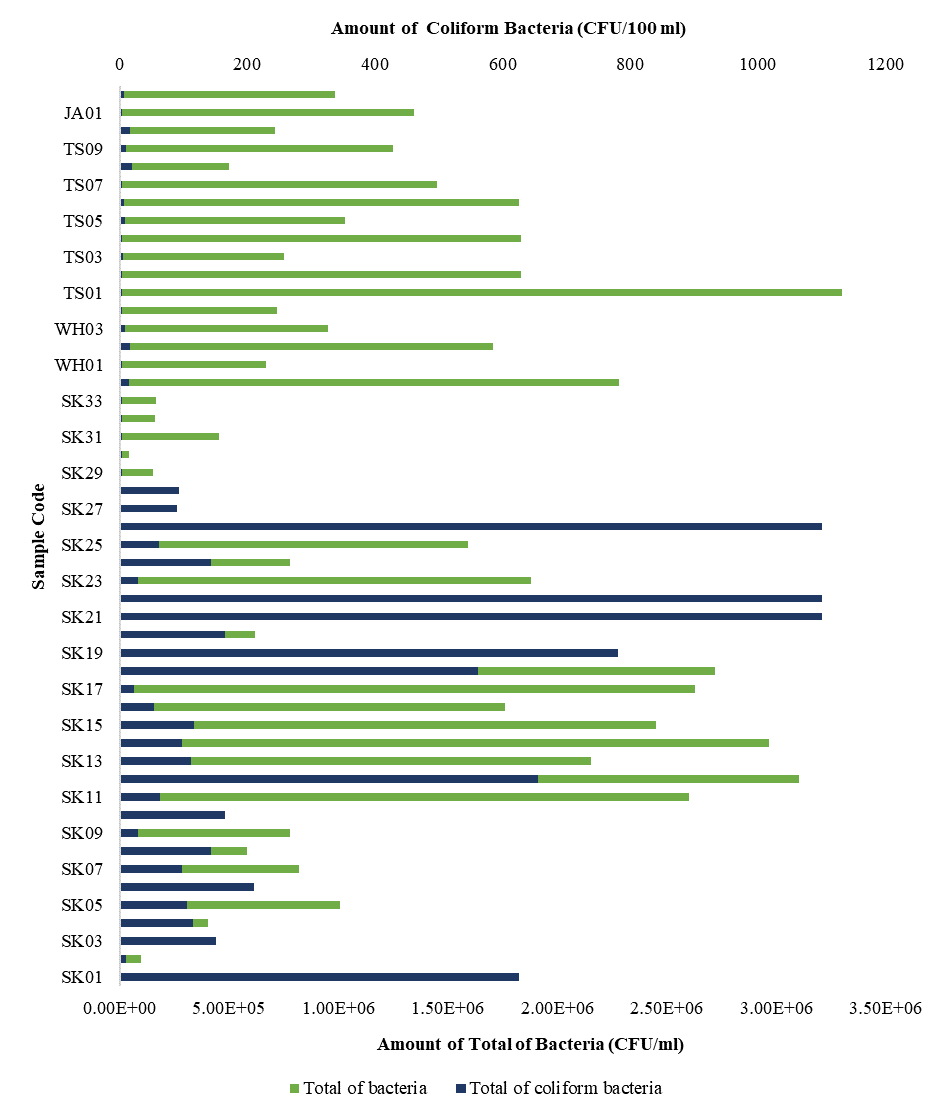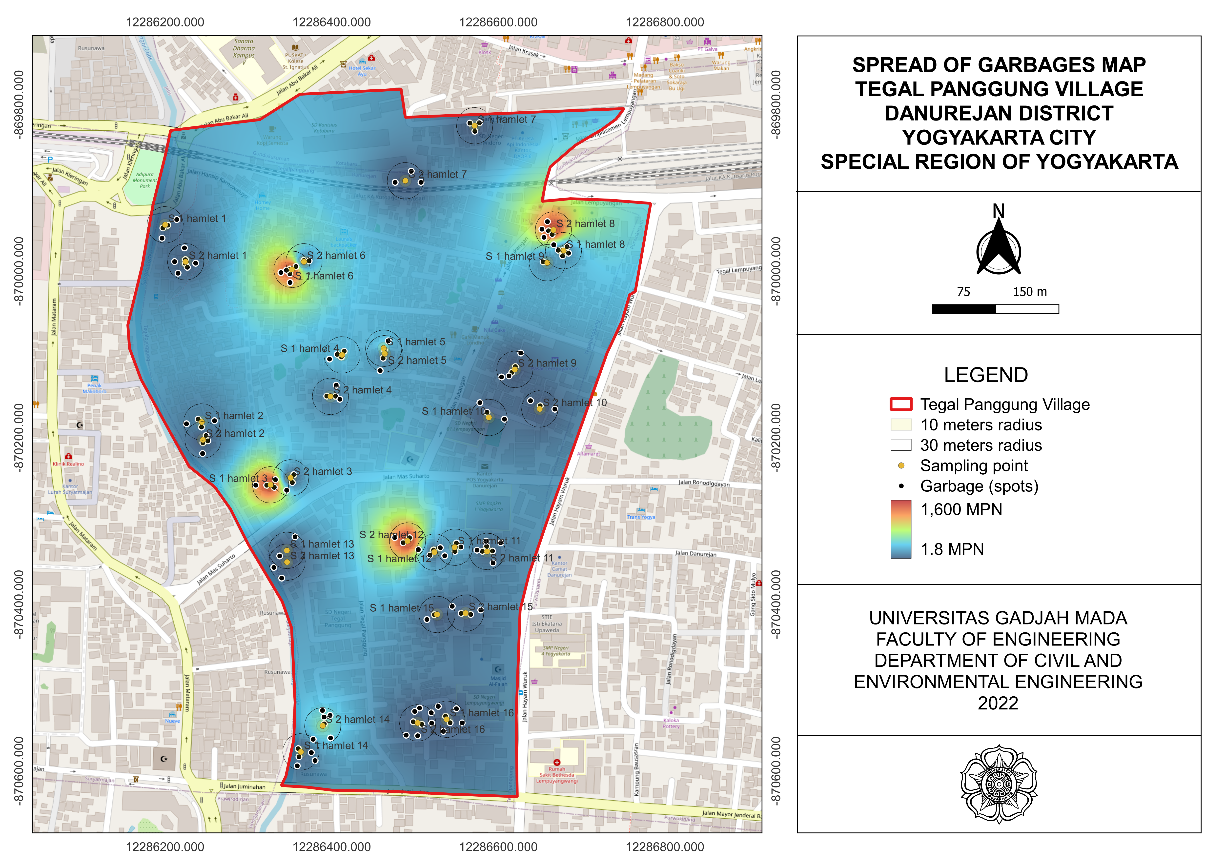Identification of Airborne Aerobic Bacteria in the Intensive Care Room using MALDI-TOF MS

Introduction: Indoor air quality can affect the spread of airborne microorganisms which can lead to healthcare-associated infections (HAIs). The quality and quantity of airborne microorganisms are responsible for mortality and morbidity in infection-prone hosts such as patients admitted to the intensive care unit (ICU). The research aims to determine the quality of microorganisms in the air, identify the types of aerobic bacteria, and assess the physical parameters of the air in the ICU. Methods: This study was a cross-sectional study with a descriptive observational method. Air specimens were collected using the MAS-100 NT tool with blood agar plate solid culture media, which then incubated in an aerobic atmosphere for 24 hours at 37±2°C. Observation and measurement of air microbiological quality was by counting the number of microorganisms in CFU/m3 and identification of bacteria using MALDI-TOF MS. Results and Discussion: The maximum concentration of microorganisms in the air exceeds the standard value, and the average value of the concentration of microorganisms in the air is 736 CFU/m3. The most common types of aerobic bacteria in the air were Bacillus sp. (n=12), Coagulase-negative Staphylococci (n=5), and Staphylococcus aureus (n=5). There was an increase in physical parameters in the form of average temperature (26.24°C) and humidity (70%) with a ventilation system and air regulation using mechanical ventilation sourced from a split air conditioner with an exhaust fan without a high-efficiency particulate-absorbing (HEPA) filter. Conclusion: Low indoor air quality has the potential to increase the concentration of microorganisms and bacterial findings in the air
Ministry of Health Republic of Indonesia. Regulation of the Minister of Health of the Republic of Indonesia Number 7 of 2019 concerning Hospital Environmental Health. Jakarta: Ministry of Health Republic of Indonesia; 2019.
Kumar P, Kausar MA, Singh AB, Singh R. Biological Contaminants in the Indoor Air Environment and Their Impacts on Human Health. Air Qual Atmos Health. 2021;14(11):1723–1736. https://link.springer.com/10.1007/s11869-021-00978-z
Minister of Health Republic of Indonesia. Regulation of the Minister of Health of the Republic of Indonesia Number 27 of 2017 concerning Guidelines for Infection Prevention and Control in Health Service Facilities. Jakarta: Minister of Health Republic of Indonesia; 2017.
Minister of Health Republic of Indonesia. Decree of the Minister of Health of the Republic of Indonesia Number 1204/MENKES/2004 concerning Hospital Environmental Health Requirements. Jakarta: Minister of Health Republic of Indonesia; 2004.
Susanto AD, Sanie DK, Fitriani F. Dampak Bioaerosol terhadap Pernapasan. Jk Unila. 2019;3(2):272–282. https://juke.kedokteran.unila.ac.id/index.php/JK/article/view/2498
Lastinger LMW, Pattabiraman V, Konnor RY, Patel PR, Wong E, Xu SY, et al. The Impact of Coronavirus Disease 2019 (COVID-19) on Healthcare-Associated Infections in 2020: A Summary of Data Reported to the National Healthcare Safety Network. Infect Control Hosp Epidemiol. 2022;43(1):12–25. https://pubmed.ncbi.nlm.nih.gov/34473013/
Zhai Y, Li X, Wang T, Wang B, Li C, Zeng G. A Review on Airborne Microorganisms in Particulate Matters: Composition, Characteristics and Influence Factors. Environ Int. 2018;113(1):74–90. https://doi.org/10.1016/j.envint.2018.01.007
Monegro AF, Muppidi V, Regunath H. HospitalAcquired Infections. Cambridge Handbook of Psychology, Health and Medicine. 2023;2(1):736–738. https://www.ncbi.nlm.nih.gov/books/NBK441857/
Arıkan I, Genç Ö., Uyar C, Tokur ME, Balcı C, Renders DP. Effectiveness of Air Purifiers in Intensive Care Units: an Intervention Study. J Hosp Infect. 2021;120(1):14-22. https://doi.org/10.1016/j.jhin.2021.10.011
Despotovic A, Milosevic B, Milosevic I, Mitrovic N, Cirkovic A, Jovanovic S, et al. Hospital-Acquired Infections in the Adult Intensive Care Unit-Epidemiology, Antimicrobial Resistance Patterns, and Risk Factors for Acquisition and Mortality. Am J Infect Control. 2020;48(1):1211–1215. https://doi.org/10.1016/j.ajic.2020.01.009
Haque M, Sartelli M, McKimm J, Abu Bakar M. Healthcare-Associated Infections-an Overview. Infection and Drug Resistance. 2018;11(1):2321–2333. http://dx.doi.org/10.2147/IDR.S177247
Stewart S, Robertson C, Pan J, Kennedy S, Dancer S, Haahr L, et al. Epidemiology of Healthcare-Associated Infection Reported from a Hospital-wide Incidence Study: Considerations for Infection Prevention and Control Planning. J Hosp Infect. 2021;114(1):10–22. https://doi.org/10.1016/j.jhin.2021.03.031
Serra-Burriel M, Keys M, Campillo-Artero C, Agodi A, Barchitta M, Gikas A, et al. Impact of Multi-Drug Resistant Bacteria on Economic and Clinical Outcomes of Healthcare-Associated Infections in Adults: Systematic Review and Meta-Analysis. PLoS One. 2020;15(1):1–14. https://doi.org/10.1371/journal.pone.0227139
Smith J, Adams CE, King MF, Noakes CJ, Robertson C, Dancer SJ. Is There an Association Between Airborne and Surface Microbes in the Critical Care Environment?. J Hosp Infect. 2018;100(3):e123–e129. https://doi.org/10.1016/j.jhin.2018.04.003
Gonzalez-Martin C. Airborne Infectious Microorganisms. In: Encyclopedia of Microbiology. Elsevier. 2019;4(1):52–60. https://doi.org/10.1016/B978-0-12-809633-8.13002-X
Hiwar W, King MF, Shuweihdi F, Fletcher LA, Dancer SJ, Noakes CJ. What is the Relationship Between Indoor Air Quality Parameters and Airborne Microorganisms in Hospital Environments? A Systematic Review and Meta-analysis. Wiley. 2021;31(5):1308–1322. https://doi.org/10.1111/ina.12846
Abdelrahman H, Abu-Rub L, Al Mana H, Alhorr Y, Al Thani A, Qotba H, et al. Assessment of Indoor Air Quality of Four Primary Health Care Centers in Qatar. Microorganisms. 2022;10(10):1–15. https://doi.org/10.3390/microorganisms10102055
Wisudawan B O. Analisis Risiko dan Model Dinamis Polusi Bioaerosol pada RSUP.Dr.Wahidin Sudirohusodo Makassar. Disertasi. Makassar: Universitas Hassanudin; 2020.
Kayta G, Manilal A, Tadesse D, Siraj M. Indoor Air Microbial Load, Antibiotic Susceptibility Profiles of Bacteria, and Associated Factors in Different Wards of Arba Minch General Hospital, Southern Ethiopia. PLoS One. 2022;17(7):1–19. https://doi.org/10.1371/journal.pone.0271022
Karigoudar RM, Wavare SM, Kakhandki L, Bagali S, Kumar IH. Comparison of Active and Passive Methods of Air Sampling to Evaluate the Microbial Contamination of Air in Operation Theaters. J Pure Appl Microbiol. 2020;14(4):2691–2697. https://doi.org/10.22207/JPAM.14.4.47
Du W, Li X, Chen Y, Shen G. Household Air Pollution and Personal Exposure to Air Pollutants in Rural China – A review. Environmental Pollution. 2018;237(1):625–638. https://doi.org/10.1016/j.envpol.2018.02.054
Shajahan A, Culp CH, Williamson B. Effects of Indoor Environmental Parameters Related to Building Heating, Ventilation, and Air Conditioning Systems on Patients' Medical Outcomes: A Review of Scientific Research on Hospital Buildings. Indoor Air. 2019;29(2):161–176. https://doi.org/10.1111/ina.12531
Abu-Rub LI, Johar ARA, Al Mana H, Abdelrahman HA, Althani AA, Qotba H, et al. Bacterial Indoor Air Contaminations in Hospitals in MENA Region: a Systematic Review. Int J Environ Health Res. 2022;33(12):1218–1232. https://doi.org/10.1080/09603123.2022.2083087
AlRayess S, Sleiman A, Alameddine I, Fayad AA, Matar GM, El-Fadel M. Airborne Bacterial and PM Characterization in Intensive Care Units: Correlations with Physical Control Parameters. Air Qual Atmos Health. 2022;15(10):1869–1880. https://doi.org/10.1007/s11869-022-01222-y
Lin Y, Alstrup M, Pang JKY, Maróti G, Er-Rafik M, Tourasse N, et al. Adaptation of Bacillus thuringiensis to Plant Colonization Affects Differentiation and Toxicity. mSystems. 2021;6(5):1–22. https://doi.org/10.1128/msystems.00864-21
Glasset B, Herbin S, Granier SA, Cavalie L, Lafeuille E, Guérin C, et al. Bacillus cereus, a Serious Cause of Nosocomial Infections: Epidemiologic and Genetic Survey. PLoS One. 2018;13(5):1–19. https://doi.org/10.1371/journal.pone.0194346
Ehling-Schulz M, Lereclus D, Koehler TM. The Bacillus cereus Group: Bacillus Species with Pathogenic Potential. Microbiology Spectrum. 2019;7(3):1–35. https://doi.org/10.1128/microbiolspec.gpp3-0032-2018
Siddiqui AH, Koirala J. Methicillin-Resistant Staphylococcus aureus. Vulvar Disease: Breaking the Myths. 2023; 301–302. https://www.ncbi.nlm.nih.gov/books/NBK482221/
Kozajda A, Jeżak K, Kapsa A. Airborne Staphylococcus aureus In Different Environments-a Review. Environmental Science and Pollution Research. 2019;26(1):34741–34753. https://doi.org/10.1007/s11356-019-06557-1
Kunwar A, Tamrakar S, Poudel S, Sharma S, Parajuli P. Bacteriological Assessment of the Indoor Air of Different Hospitals of Kathmandu District. Int J Microbiol. 2019;2019(1):1–9. https://doi.org/10.1155/2019/5320807
Eltwisy HO, Abdel-Fattah M, Elsisi AM, Omar MM, Abdelmoteleb AA, El-Mokhtar MA. Pathogenesis of Staphylococcus haemolyticus on Primary Human Skin Fibroblast Cells. Virulence. 2020;11(1):1142–1157. https://doi.org/10.1080/21505594.2020.1809962
TauÅ¡an í, RanÄić N, Kostić Z, Ljubenović N, Rakonjac B, Å uljagić V. An Assessment of Burden of Hospital-Acquired Pneumonia Among Abdominal Surgical Patients in Tertiary University Hospital in Serbia: a Matched Nested Case-Control Study. Front Med (Lausanne). 2022;9(1):1040654. https://pubmed.ncbi.nlm.nih.gov/36569168/
Banerjee T, Mishra A, Das A, Sharma S, Barman H, Yadav G. High Prevalence and Endemicity of Multidrug Resistant Acinetobacter spp. in Intensive Care Unit of a Tertiary Care Hospital, Varanasi, India. J Pathog. 2018;2018(1):1–8. https://doi.org/10.1155/2018/9129083
Szabó S, Feier B, Capatina D, Tertis M, Cristea C, Popa A. An Overview of Healthcare Associated Infections and Their Detection Methods Caused by Pathogen Bacteria in Romania and Europe. J Clin Med. 2022;11(11):3204. https://doi.org/10.3390/jcm11113204
Yuan F, Qiu W, Xia Y, Chen Q, Li J, Liang J, et al. Contamination of Drug-Resistant Acinetobacter Baumannii and its Antibiotic Resistance Genes in the Dust on the Return Vent Filters of Air-Conditioners in Hospital Wards. Res Sq. 2022;2022(1):1–17. https://doi.org/10.21203/rs.3.rs-1774903/v1
Saran S, Gurjar M, Baronia A, Sivapurapu V, Ghosh PS, Raju GM, et al. Heating, Ventilation and Air Conditioning (HVAC) in Intensive Care Unit. Crit Care. 2020;24(194):1–11. https://doi.org/10.1186/s13054-020-02907-5
Alizadeh M, Yousefi L, Pakdel F, Ghotaslou R, Rezaee MA, Khodadadi E, et al. MALDI-TOF Mass Spectroscopy Applications in Clinical Microbiology. Adv Pharmacol Pharm Sci. 2021;2021(9928238):1-8. https://doi.org/10.1155/2021/9928238
Hou TY, Chiang-Ni C, Teng SH. Current Status of MALDI-TOF Mass Spectrometry in Clinical Microbiology. J Food Drug Anal. 2019;27(2):404–414. https://doi.org/10.1016/j.jfda.2019.01.001

This work is licensed under a Creative Commons Attribution-NonCommercial-ShareAlike 4.0 International License.
1. Copyright of all journal manuscripts is held by the Jurnal Kesehatan Lingkungan.2. Formal legal provisions to access digital articles of electronic journal are subject to the provision of the Creative Commons Attribution-ShareAlike license (CC BY-NC-SA), which means that Jurnal Kesehatan Lingkungan is rightful to keep, transfer media/format, manage in the form of databases, maintain, and publish articles.
3. Published manuscripts both printed and electronic are open access for educational, research, and library purposes. Additionally, the editorial board is not responsible for any violations of copyright law.
JKESLING by UNAIR is licensed under a Creative Commons Attribution-ShareAlike 4.0 International License.







































